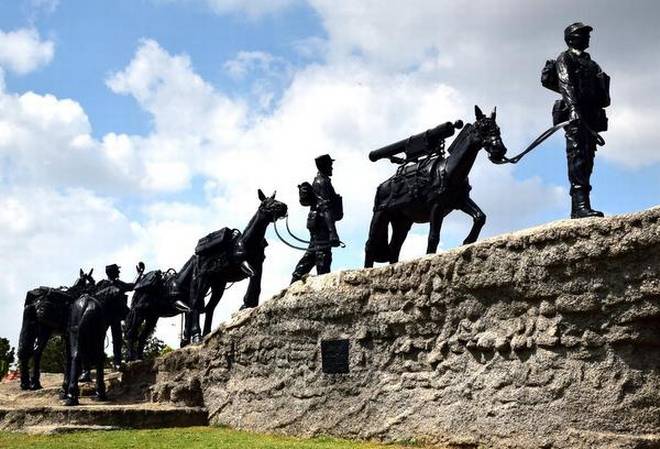Indian Army
This is a collection of articles archived for the excellence of their content. |
Contents |
Mountain strike corps
17 Corps
The raising of the corps
The Times of India, May 04 2016
Use of war reserves for new corps suicidal
Rajat Pandit
A parliamentary panel has sounded the alarm at the way the Army is being forced to cannibalise its existing reserves to raise the new mountain strike corps needed to acquire effective conventional deterrence against China.
“Milking existing resources, which in some cases are not fully up to authorisation, is suicidal,“ said the parliamentary standing committee on defence in its latest report, tabled on Tuesday .
The committee asked the defence ministry to “critically examine“ the issue and report back within two months.“The committee feels raising of the mountain strike corps is in the interest of national security and recommends that necessary funds for infrastructure development are released for it,“ it said.
In a series of reports, TOI has earlier highlighted how the 1.18-million strong Army was struggling to raise the new mountain strike corps, the 17 Corps, by dipping into its critical war wastage reserves (WWR) in the absence of dedicated funding. This becomes all the more alarming since the Army cannot fight a war beyond 15 days because of crippling shortages in its ammunition stocks, especially for tanks, air defence weapons and anti-tank guided missiles.This, when the approved norm is to hold ammunition for 40 days of “intense“ fighting under the WWR since it can prove critical in winning wars.
“It will not be possible for the Army to reach 100% WWR even by 2019-2020. Moreover, operational deficiencies continue in howitzers, helicopters, air defence weapons, night-fighting capabilities and the like,“ said an official.
The raising of the 17 Corps, with 90,274 additional soldiers, was approved by the UPA-II regime in July 2013 at a cost of Rs 64,678 crore spread over eight years till 2020-2021. But defence minister Manohar Parrikar has repeatedly attacked UPA for sanctioning the 17 Corps in an “arbitrary manner“ without any financial allocation or proper planning. The proposal for another Rs 26,155 crore for infrastructure and capability development along the northern borders is yet to be even approved.
Parrikar has also reiterated that the Army needs to cut down its non-operational flab and manpower in the face of escalating wage and pension bills. Even as a high-level committee is now being set up to look into this, the Army says there is very little scope for manpower cuts till it inducts “cutting-edge technology , platforms and systems“ to offset “boots on the ground“ along the two long unresolved borders with China and Pakistan.
Bengaluru: First Motorised Transport Heritage Park
The Hindu, December 6, 2016

The Indian Army is on the hunt, and this is no ordinary ‘mission’. It is tracking down decommissioned vehicles that it had once used through its vibrant history. The aim is to curate jeeps, trucks, among other vehicles, at the Army’s first Motorised Transport (MT) Heritage Park, which was inaugurated in Bengaluru.
The park, a first of its kind resting place for the Army’s most popular transport vehicles, is an endeavour of the officers of the Faculty of Transport Management, located at the Army Service Corps (ASC) Centre and College, Old Airport Road. The first five vehicles to be displayed at the park were put together painstakingly from 2015 in New Delhi before being transported by road to Bengaluru.
“This is a memorial for the silent transporters of the Indian Army. The idea is based on a similar museum in England. We are trying to get models of all old vehicles used in the Army, but it’s tough as many have been auctioned or scrapped. In the future, the park will also include models of all vehicles which the Army will stop using, like the Ambassador which is slated to be stopped five to six years from now,” said Lieutenant General S.P.S. Katewa, AVSM, Commandant ASC Centre and College.
At present, the park includes a Jeep Willys 4X4, a 3-tonne Shaktiman truck, a Nissan Patrol (JONGA), a Tata-Mercedes Benz (TMB) truck, and a 1-tonne Vahan truck.
Memorial for animals
The ASC Centre also hosts a memorial for pack mules and other animals that the Supply Corps uses extensively. “There was talk during the Kargil War of wanting to cut down on the use of animal transport, but with hard-to-reach front lines in the eastern borders with China, we still continue to use these animals for transport. We are the only corps to use pack mules and we wanted to raise a memorial for these animals as well,” a senior ASC officer said.
The public have to apply for prior permission to view the memorials. “We bring children from schools and colleges here as part of the ‘Know your Army’ programmes. We can permit the public on special days, with proper security arrangements,” Lt. Gen. Katewa said.